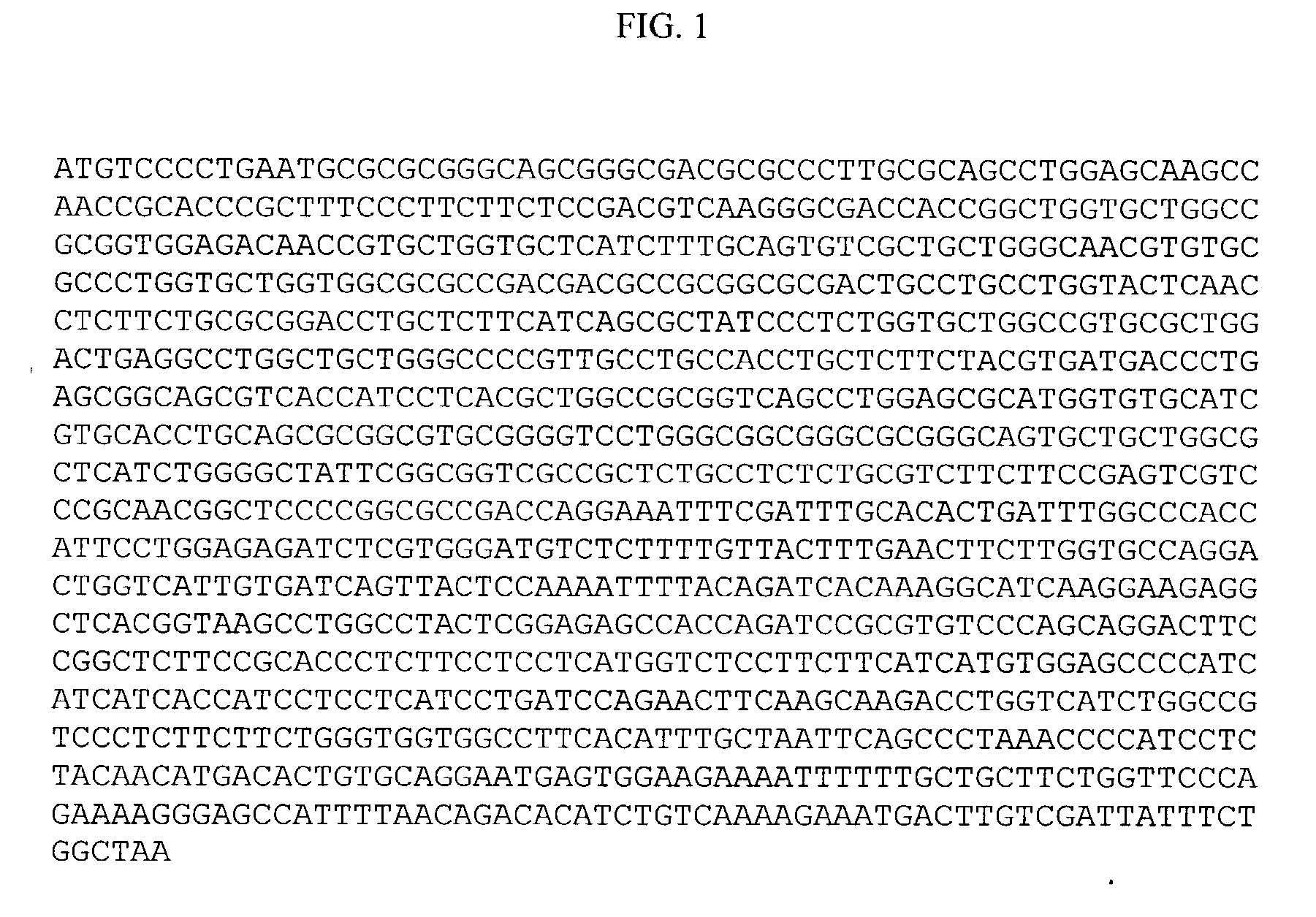Novel human G-protein coupled receptor, HGPRBMY18, expressed highly in pituitary gland and colon carcinoma cells
- Summary
- Abstract
- Description
- Claims
- Application Information
AI Technical Summary
Benefits of technology
Problems solved by technology
Method used
Image
Examples
example 1
Bioinformatics Analysis
[0255] G-protein coupled receptor sequences were used as a probe to search the Incyte and public domain EST databases. The search program used was gapped BLAST (S. F. Altschul, et al., Nuc. Acids Res., 25:3389-4302 (1997)). The top EST hits from the BLAST results were searched back against the non-redundant protein and patent sequence databases. From this analysis, ESTs encoding potential novel GPCRs were identified based on sequence homology. The Incyte EST (CloneID:5029478) was selected as a potential novel GPCR candidate, called HGPRBMY18, for subsequent analysis. This EST was sequenced and the full-length clone of this GPCR was obtained using the EST sequence information and conventional methods. The complete protein sequence of HGPRBMY18 was analyzed for potential transmembrane domains. The TMPRED program (K. Hofmann and W. Stoffel, Biol. Chem., 347:166 (1993)) was used for transmembrane prediction. The program predicted seven transmembrane domains and th...
example 2
Cloning of the Novel Human GPCR HGPRBMY18
[0256] Using the EST sequence, an antisense 80 base pair oligonucleotide with biotin on the 5' end was designed that was complementary to the putative coding region of HGPRBMY18 as follows: 5'-b-AGC AGG TGG TCG CCC TTG ACG TCG GAG AAG AAG GGA AAG CGG GTG CGG TTG GCT TGC TCC AAG GTG AAG AAG GGC GCG TA-3' (SEQ ID NO:5). This biotinylated oligo was incubated with a mixture of single-stranded covalently closed circular cDNA libraries, which contained DNA corresponding to the sense strand. Hybrids between the biotinylated oligo and the circular cDNA were captured on streptavidin magnetic beads. Upon thermal release of the cDNA from the biotinylated oligo, the single stranded cDNA was converted into double strands using a primer homologous to a sequence on the cDNA cloning vector. The double stranded cDNA was introduced into E. coli by electroporation and the resulting colonies were screened by PCR, using a primer pair designed from the EST sequenc...
example 3
Expression Profiling of Novel Human GPCR, HGPRBMY18
[0261] The same PCR primer pair used to identify HGPRBMY18 cDNA clones (HGPRBMY18s-SEQ ID NO:6 and HGPRBMY18a-SEQ ID NO:7) was used to measure the steady state levels of mRNA by quantitative PCR. Briefly, first strand cDNA was made from commercially available mRNA (Clontech; Palo Alto, Calif.). The relative amount of cDNA used in each assay (2.5 ng of cDNA per assay) was determined by performing a parallel experiment using a primer pair for the cyclophilin gene, which is expressed in equal amounts in all tissues. The cyclophilin primer pair detected small variations in the amount of cDNA in each sample, and these data were used for normalization of the data obtained with the primer pair for HGPRBMY18. The PCR data were converted into a relative assessment of the difference in transcript abundance among the tissues tested and the data are presented in FIG. 7. Transcripts corresponding to the orphan GPCR, HGPRBMY18, were found to be h...
PUM
| Property | Measurement | Unit |
|---|---|---|
| Length | aaaaa | aaaaa |
| Length | aaaaa | aaaaa |
| Antigenicity | aaaaa | aaaaa |
Abstract
Description
Claims
Application Information
 Login to View More
Login to View More - R&D
- Intellectual Property
- Life Sciences
- Materials
- Tech Scout
- Unparalleled Data Quality
- Higher Quality Content
- 60% Fewer Hallucinations
Browse by: Latest US Patents, China's latest patents, Technical Efficacy Thesaurus, Application Domain, Technology Topic, Popular Technical Reports.
© 2025 PatSnap. All rights reserved.Legal|Privacy policy|Modern Slavery Act Transparency Statement|Sitemap|About US| Contact US: help@patsnap.com



